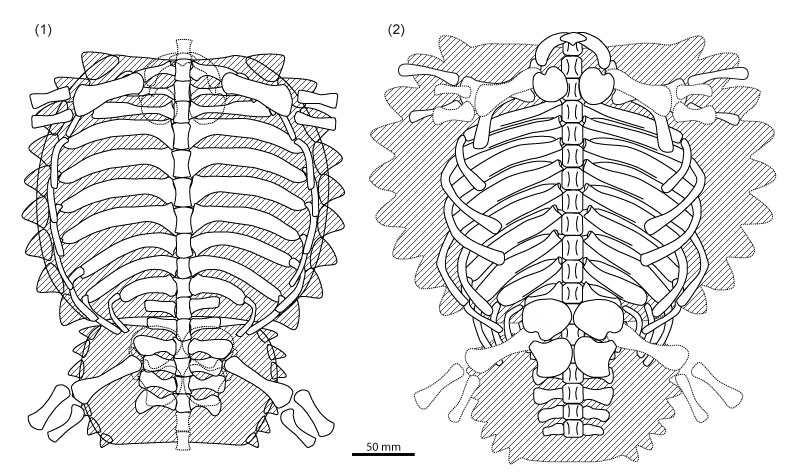![]()
FIGURE 10. Comparison of the novel (1) vs. previous (2) interpretations of the postcranial skeleton and associated armour of Cyamodus hildegardis. (1) In the novel interpretation, the shape of the round main carapace shield is interpreted to be roughly mirrored by the transverse processes and associated ribs. Note that the shapes of these skeletal elements were adapted from PIMUZ T58, thus they are not shown in a strictly ventral view. Dorsal 11 and 12 are reconstructed without ribs, thus the total number of ribs shown mirrors the numbers shown in Pinna (1980, figure 1). The pelvic shield covers the complete sacral region and the base of the tail roughly up to caudal 3. The gap between the armour shields lies at the level of dorsal 12. The positions of the pectoral and pelvic girdles (adapted from Pinna 1980, figure 1), as well as a cervical and two caudal centra are indicated by dotted lines. (2) Previous reconstructions of the postcranial skeleton (adapted from Pinna 1980, figure 1; solid lines) and overall armour shape (adapted from Pinna 1992, figure 19; dotted lines). The interpretative sketch of the skeleton based on the juvenile specimen MSNM V458 has been simply superimposed and scaled to the same size (based on humerus proportions) as the armour shape based on the older specimens. Following these sketches, the main carapace would cover the trunk region from dorsal 1 to sacral 1, whereas the pelvic shield covers the area from sacral 3 to at least caudal 6. Otherwise, the main carapace is too wide to show a closer association with the underlying endoskeletal elements. Note the differences in the proportions of the zeugopodial elements. For colour coding of elements see Figure 6, Figure 7, Figure 8, and Figure 9. (A greyscale version of this figure is also available).

